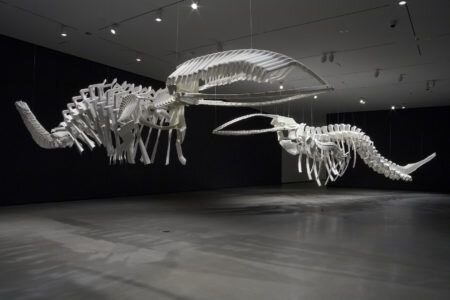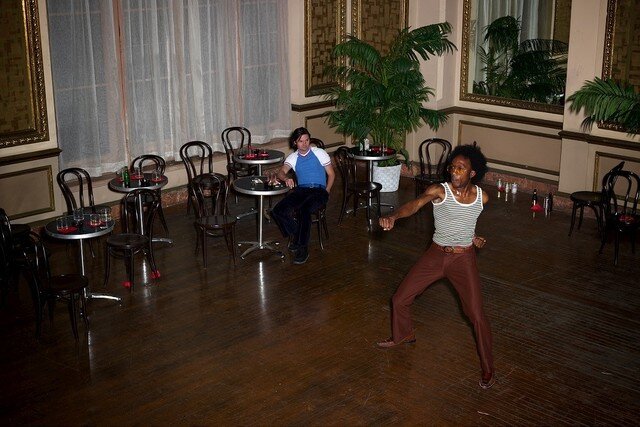In this post I am going to discuss sharing contemporary art to my chosen audience, my high school age digital art students. The media and vehicle that I am going to utilize for this experience will be the program, Art21. I am going to focus on the 8th season of the show from 2016 where the focus was on how artists in particular areas have a unique and individual relationship with the places where they are making art. Locations included Chicago, Los Angeles, Mexico City and the episode I chose, Vancouver.
Vancouver, British Columbia is bustling seaport city located in the Northwestern portion of North America. Having an ethnically diverse population, it is home to a thriving art scene that not only explores contemporary art but also celebrates indigenous arts of the First Nation culture. Four artists art featured in the Vancouver episode of Art21: Liz Magor, Stan Douglas, Brian Jungen and Jeff Wall. Each manipulates elements of their environment in ways that are directly tied to their individual experience and creates art that reflects those experiences. The Big Idea of the episode is the process by which all of these artists craft and manipulate objects, scenes and moments into new experiences for the viewer.
Liz Magor
Liz Magor: Surrender, Art Gallery of Ontario, Toronto
August 29 – November 29, 2015
Magor muses in the episode, “Art is not a certain product, it is the choices that I have been able to make.” Eluding to her process as being as important as the result, she discusses how she looks for art in the environment around us. She works in what she calls the “nether zone, not needed zone.” She explores the waste stream and the things we consume and replace like clothes, structures and even our living spaces. Looking to tap into the small things just under the radar of our everyday lives, like the little anxieties we harbor over objects and maintenance, upkeep and repair.
“Creating an experience for looking” as she describes it, she often works pieces of refuse or used objects into her sculptural works. Recreating a casted shanty cabin out of aluminum, or resin castes of gloves and old boxes housing dead birds, she explores our ever-changing lives and the things and objects moving through them. Ultimately, we also become part of the impermanence and die.
Stan Douglas
Kung Fu Fighting, 1975 Stan Douglas 2012
Douglas, a filmmaker and theater person turned artist, uses history to make interactive media to retell stories of the past. “I often depict minor histories, but I always try to depict a local symptom of a global condition.” He notes that history does repeat itself and events do play out again and again, but it is usually because the symptoms that cause actions never went away.
Douglas’s work includes multiple audio, visual and theatrical elements. He recreated events from a festival in Vancouver where police descended upon locals, staging historical scenes and documenting them in photographs. In another piece, he created a film noir recreation of Hogan’s Alley neighborhood in Vancouver, B.C. with live actors imposed on computer generated environments. Titled The Secret Agent, it is a video project that explores terrorism in film recreations. Staged events looping in a large simultaneous video exhibition explores the act of terrorism and how individuals impose their views upon others.
Brian Jungen
Brian Jungen, Prototype for New Understanding #18, 2004
Jungen, a native Canadian, creates sculptural works that reflect indigenous cultures and imagery from his own native heritage and areas around Vancouver. Originally, he tried to hide behind his art, but ended up having his identity become wrapped up in and a major storytelling element of his works as he talks about his experience.
He enjoys creating sculptural works from things people can recognize from their everyday life. Creating life size whale skeletons out of cheap resin chairs or recreating northwest native art out of Nike athletic shoes. Drums intricately created in tribal fashion using modernist furniture and other such works allow for the viewer to connect with the familiar materials while seeing the native influence of Jungen.
Jeff Wall
After ‘Invisible Man’ by Ralph Ellison, the Prologue, 1999-2000
The social value of art is that it gives experiences, Wall explains and so her says he is “always looking for that picture.” Originally a painter, alternative artmaking deflected him into exploratory photography. More than just a mere photographer, Wall stages photographs in an artistic recreation of scenes to manipulate events.
He talks of capturing gesture in photography, whether by accident or by design is not fakery since the photograph records only what it sees in front of it. Wall muses, “pictures can never narrate...they can only imply a narrative, but they cannot deliver. So what the viewer is doing is really writing the story...they are intuiting a narrative for themselves, which will not be the same for everybody.”
Discussion Questions for this Episode:
How are these artists reflecting the culture and social experiences around them in their art?
Each of the artists is dealing with working history and the past into their art in unique ways. Discuss how they are each individually processing historical information into their art.
How do these artists manipulate the everyday events, scenes, objects and interactions into new experiences?
Jeff Wall speaks about “fakery” and defends his process of creating highly staged images and scenes to photograph. Each of these artists is manipulating your view to give an altered experience. Discuss the “truthfulness” of these pieces of art.
Activity:
Liz Magor creates castes of used and “useless” objects to change their impermanent state into a lasting one with artistic value. Brian Jungen manipulates everyday objects into artistic artifacts with connections to his culture and heritage.
Take an everyday object and use Photoshop to deconstruct, duplicate and manipulate it into something new. For instance, Jungen made a whale skeleton using white plastic chairs and native masks out of Nike shoes.
Stan Douglas recreates historical instances with creative film and photography. Jeff Wall looks for instances to recreate in new and visually impactful ways.
Using Photoshop, create and manipulate a scene to recreate a historical event. Use multiple images and elements to drive your storytelling. Think about the experience you want to share.
Additional Resources
Museum of Anthropology Vancouver https://moa.ubc.ca/
Liz Magor Selected Works at Andrew Kreps Gallery http://www.andrewkreps.com/artists/liz-magor
Stan Douglas on ArtNet http://www.artnet.com/artists/stan-douglas/
Brian Jungen Selected Works at Catriona Jeffries Gallery https://catrionajeffries.com/artists/brian-jungen/works
Jeff Wall on Artsy.net https://www.artsy.net/artist/jeff-wall
Art21 (September 23, 2016) Vancouver, Art in the Twenty-First Century. Season 8. Retrieved 10/15/2020 from https://art21.org/watch/art-in-the-twenty-first-century/s8/vancouver/




